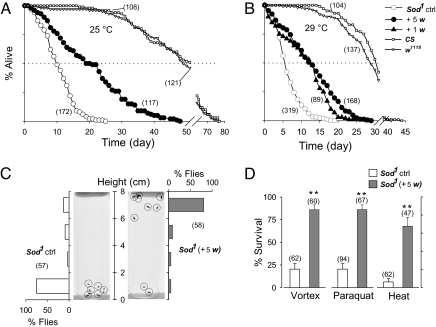Fig. 1.
Extension of lifespan, coupled with enhanced motor ability and stress resistance, of Sod flies by cohousing with helper flies. (A and B) Lifespan extension at 25 and 29°C. 4–10 Sod1 flies (2–3 days old) were cohoused with w1118 flies in each food vial. When cohoused with five helpers (filled circle), Sod1 flies showed significant lifespan extension compared with control (open circle), P < 0.0001. This was true even for a single helper (B, filled triangle), P < 0.0001. Lifespan of w1118 helper and wild-type CS at 25 and 29°C are shown for comparison in A and B. (C) Improved motor ability. Cohoused and control Sod1 flies, both aged for 10 days at 25°C, were tested for climbing ability after mechanical agitation. As illustrated in the photographs (flies circled) and bar graphs (pooled from 10 trials), cohoused flies (Right, gray bars) climbed significantly higher than control (Left, open bars) 10 sec after the vials were tapped. (D) Enhanced stress resistance. Cohoused (gray bars) and control (open bars) Sod1 flies aged at 25°C were challenged by mechanical stress of vortexing (left) on 3 consecutive days from the 10th day, or by 6-hr oxidative stress (paraquat feeding, Center) or heat stress (exposure to 38°C, Right) on the 9th day. Cohoused flies showed much higher survivorship compared with control. **, P < 0.01, paired t test. In this and the following figures, only male flies were used, with their numbers indicated in parentheses for each experiment.

